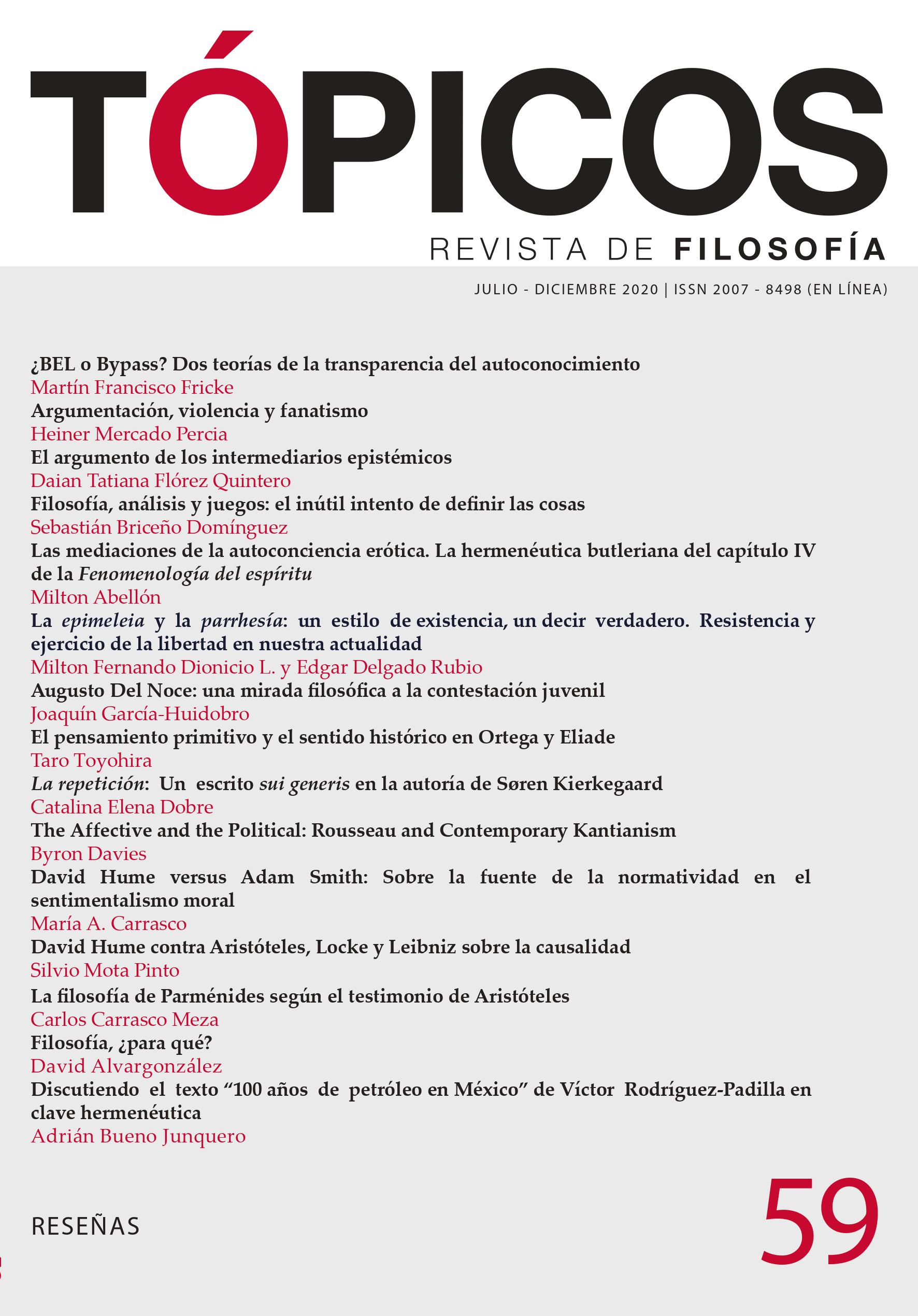La repetición: Un escrito sui generis en la autoría de Søren Kierkegaard
Publicado 2020-06-27
Palavras-chave
- repetición,
- recuerdo,
- libertad,
- devenir,
- filosofía
- movimiento ...Mais
Como Citar
Resumo
Considerada una de las categorías más complejas del pensamiento de Søren Kierkegaard, la repetición sigue hasta la fecha causando mucha inquietud dentro de su propia autoría. Aunque sobre esta categoría encontramos unos primeros esbozos en un escrito inconcluso titulado Johannes Climacus o el dudar de todas las cosas, mucho más tarde Kierkegaard retomará la categoría de repetición en su escrito con el mismo nombre: La repetición, un escrito peculiar y difícil de entender en su propia dinámica. Por lo mismo, en estas páginas proponemos una interpretación de la categoría de repetición en relación con el escrito del mismo nombre para entender por qué la repetición es una categoría espiritual, como Kierkegaard mismo la pensaba, partiendo de la idea de que para el filósofo danés la repetición es lo que podemos llamar una “filosofía del futuro”.
Referências
- Kierkegaard, S. (2007). Johannes Climacus o el dudar de todas las cosas. Gloria.
- Kierkegaard, S. (2007). El concepto de la angustia. Alianza.
- Kierkegaard, S. (2008). Postscriptum no científico y definitivo a Migajas filosóficas. Univ. Iberoamericana.
- Kierkegaard, S. (2008). La enfermedad mortal. Ed. Trotta.
- Kierkegaard, S. (2009). La repetición. Alianza.
- SKS: Søren Kierkegaards Skirifter.
- Caputo, J. (1987). Radical Hermeneutics. Indiana University Press.
- Cries, S. (1993). The Bilissful Security of the Momment. Recollection, Repetition and Eternal Recurrence. En Robert L. Perkins (ed.), International Kierkegaard Commentary, vol. 6. (pp. 225-246). Mercer University Press.
- Croxall, T. H. (1948). Kierkegaard Studies. Lutherworth Press.
- Eriksen, N. N. (2000). Kierkegaard´s Category of Repetition. A reconstruction. (Monograph Series, vol. 5). De Gruyter.
- Deleuze, G. (2009). Diferencia y repetición. Amorrortu.
- Dupré, L. (1985). On Time and Eternity. En Robert L. Perkins (ed.), International Kierkegaard Commentary, vol. 8. (pp. 111-131). Mercer University Press.
- Garff, J. (2017). Kierkegaard´s Muse. The Mystery of Regine Olsen. Princeton University Press.
- Hannay, A. (2010). Kierkegaard. Una biografía. Univ. Iberoamericana.
- Holm, I. W. (1991). Kierkegaard´s Repetition: A Rethorical Reading of Søren Kierkegaard´ s Concept of Repetition. Kierkegaardiana Magazine, 15.
- Lowrie, W. (1938). Kierkegaard. Oxford University Press.
- Mackey, L. (1984). Once More with Felling. Kierkegaard´s Repetition. En R. Schleifer y R. Markley (eds.), Kierkegaard and Literature: Irony, Repetition, and Criticism. University of Oklahoma Press.
- Malantschuk, G. (1971). Kierkegaard´s Thought. Princeton University Press.
- Melberg, A. (1990). Repetition in the Kierkegaardian Sense of the Term. Diacritics Magazine, The Johns Hopkins University Press. (https://www.jstor.org/stable/465332). DOI: 10.2307/465332
- Martin, H. V. (1950). Kierkegaard: The Melancholy Dane. Philosophical Library.
- Perkins, R. L. (1993). Introduction. En Robert L. Perkins (ed.), International Kierkegaard Commentary, vol. 6. (pp. 3-8). Mercer University Press.
- Shestov, L. (1938). Kierkegaard as a Religious Philosopher. Lev Shestov. URL: http://shestov.phonoarchive.org/sar/kierkegaard1.html.
- Stack, G. (1977). Kierkegaard´s Existencial Ethics. University of Alabama Press.
- Steiner, G. (1998). The Wound of Negativity: Two Kierkegaard Texts. En J. Rée y J. Chamberlain (eds.), Kierkegaard: A Critical Reader. (pp. 103-113). Blackwell.
- Stendahl, B. K. (1976). Søren Kierkegaard. Twayne Publishers.
- Tsakiri, V. (2006). Kierkegaard. Anxiety, Repetition and Contemporaneity. Palgrave Acmillian.
- Watkin, J. (1979). Kierkegaard. Dying and Eternal Life as Paradox [Tesis doctoral]. Bristol University.







